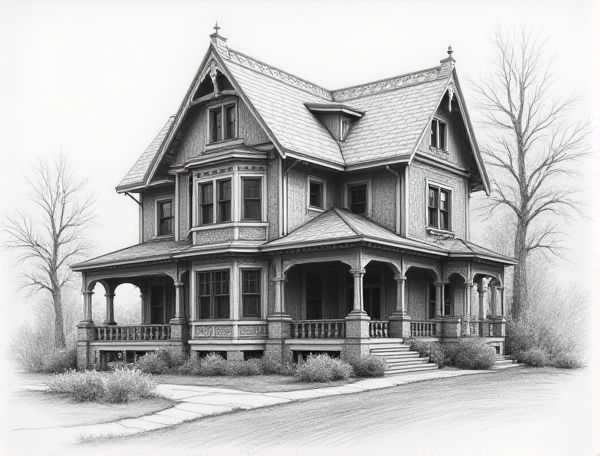
Photo illustration: Victorian home design with pressed-tin ceiling tiles
Pressed-tin ceiling tiles in Victorian home design enhance your space with intricate patterns and timeless elegance, reflecting the era's attention to detail and craftsmanship. Discover how incorporating these decorative elements can transform your interiors by reading more in the article.
Introduction to Victorian Home Design
Victorian home design features intricate woodwork, steep gable roofs, and vibrant color palettes that highlight its ornate aesthetic. Architectural elements such as bay windows, decorative trim, and asymmetrical facades contribute to its distinctive historical charm. This style originated in the mid-19th century during Queen Victoria's reign, blending Gothic, Italianate, and Queen Anne influences.
The Historical Significance of Pressed-Tin Ceiling Tiles
Pressed-tin ceiling tiles, popularized in North America during the late 19th and early 20th centuries, offered an affordable and fire-resistant alternative to ornate plaster ceilings, making high-end design accessible to middle-class homes. Their intricate patterns often reflected Victorian and Edwardian architectural styles, showcasing craftsmanship and cultural aesthetics of the period. Restoring or incorporating these tiles in modern home design preserves historical authenticity and adds unique decorative value.
Key Characteristics of Victorian Architecture
Victorian architecture is characterized by intricate woodwork, steep gabled roofs, vibrant color schemes, and asymmetrical facades often featuring bay windows and ornate trim called "gingerbread." These homes typically include decorative brackets, patterned shingles, and expansive porches that emphasize elegance and craftsmanship distinctive to the late 19th century.
Popular Patterns and Finishes for Pressed-Tin Ceilings
Pressed-tin ceilings feature popular patterns such as Victorian lace, Art Deco geometric shapes, and floral motifs that add texture and elegance to any room. Finishes range from classic metallic tones like antique bronze and silver to contemporary matte white and distressed finishes, enhancing architectural details. You can customize your home design by selecting patterns and finishes that complement your style while providing durability and easy maintenance.
Benefits of Incorporating Pressed-Tin Tiles in Victorian Interiors
Pressed-tin tiles enhance Victorian interiors with their authentic, intricate patterns that add historical charm and texture to ceilings and walls. Their durable, fire-resistant metal surface offers practical longevity while reflecting light to brighten interior spaces. Incorporating these tiles supports preservation of period aesthetics, combining vintage appeal with modern functionality in home design.
Installation Tips for Pressed-Tin Ceiling Tiles
Ensure your pressed-tin ceiling tiles are installed on a clean, level surface to enhance adhesion and prevent warping over time. Use a strong adhesive specifically designed for metal materials and secure tiles with finishing nails at the edges to maintain stability. Your precise measurements and careful alignment will create a seamless, professional look that elevates any room's aesthetic.
Color Schemes and Paint Techniques for Victorian Tin Ceilings
Victorian tin ceilings come to life with rich, historically inspired color schemes such as deep burgundy, antique gold, and soft cream, enhancing their intricate patterns and embossed details. Employing paint techniques like metallic finishes, distressing, and layering glazes accentuates the ceiling's texture and adds depth, creating an authentic vintage ambiance in any room.
Maintenance and Restoration of Pressed-Tin Tiles
Pressed-tin tiles require regular cleaning to prevent tarnish and corrosion, preserving their intricate patterns and vibrant metallic sheen. You should inspect for dents or loose tiles frequently and address repairs promptly to avoid further damage and maintain structural integrity. Applying a protective clear coat can extend the life of your pressed-tin tiles, ensuring their historical charm remains intact for years.
Complementary Victorian Interior Decor Elements
Victorian interior decor elements such as ornate crown molding, richly patterned wallpapers, and antique brass fixtures create a cohesive and complementary ambiance that enhances the historical elegance of your home. Incorporating velvet draperies, intricately carved wooden furniture, and vintage chandeliers will elevate the Victorian aesthetic, blending texture and detail seamlessly.
Modern Adaptations of Victorian Pressed-Tin Ceilings
Modern adaptations of Victorian pressed-tin ceilings transform traditional embossed metal patterns into sleek, contemporary designs using lightweight, durable materials like polyurethane. Your home can benefit from the blend of classic elegance and modern functionality, incorporating subtle metallic finishes and minimalist motifs that complement current interior aesthetics. These updated ceilings not only enhance visual appeal but also offer easy installation and maintenance, making them ideal for modern living spaces.
 homedesy.com
homedesy.com